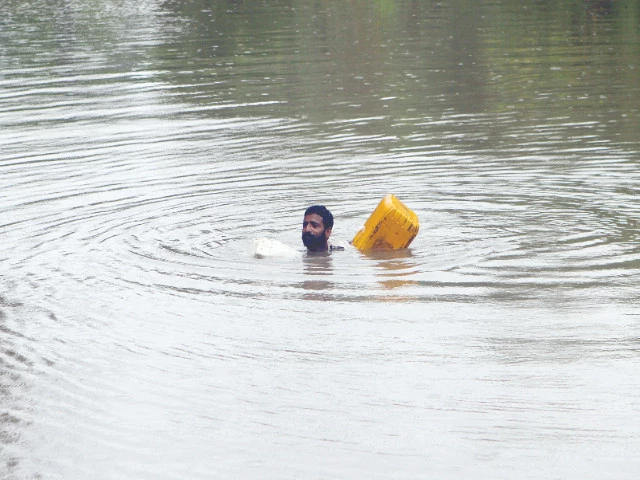Lahore/Karachi:
A high-level flood alarm was released in Punjab on Sunday after India shared information on fresh releases of water in Pakistani rivers, while national and provincial disaster control authorities warned of fresh spell for Monsun showers.
The fresh wave of floods came as the water after destroying the province over the past two weeks, on the way to Sindh, where authorities stopped for an increase of more than 800,000 cussic at Guddu Barrage on September 9 (tomorrow).
The situation in Punjab still remained uncertain floods came in waves in the three major rivers – Ravi, Sutlej and Chenab – mainly due to emissions coming from India. Authorities said the situation was critical, especially in Gujrat.
A similar situation witnessed in the southern Punjab, where the army was called in Jalalpur Pirwala for a massive evacuation operation. Last night, a 70-year-old woman died and four children in the area when a lifeboat they were aboard, enclosed in the flood water.
“The Indian High Commission informed Pakistan that the water flow in the Sutlej River would rise further,” said a spokesman for Punjab Provincial Disaster Management Authority (PDMA). “Sutlej already experiences high -level floods at Harike downstream and Ferozepur downstream.”
Punjab Nut-Relief Commissioner Nabil Javed warned that in September 9, extremely high level of flooding in Ravi, Sutlej and the Chenab rivers fears due to heavy rainfall, which can further swell the rivers.
Multan officials in the meantime confirmed that the army had been called in to help the rescue effort in Jalalpur Pirwala, where 14 army boats, eight rescue 1122 boats and five private boats provided by police are part of ongoing operations to save stranded residents.
In Mauza Bait Malanwali, a flood flood was violated during the night, flooding several settlements. Rising water levels left men, women and children trapped in the flood water with many climbing trees to save their lives.
Earlier, spoke to the media in Lahore, PDMA chief Irfan Kathia said the province of Iwas experienced its 10th Monsun -Trylle Form, which would continue until September 9. “Gujrat district has been subjected to a serious emergency in the last 24 hours due to heavy rain,” he added.
Heavy machines are inserted to drain water from Gujrat. “All roads, including Railway Road and Shah Jehangir Road, have been cleared for traffic, while water remains on Jinnah Chowk and Kaceri Road, which will be cleared in 24 hours.”
Kathia confirmed that five people drowned in a tragic boat capsize event in Jalalpur Pirwala. Chief Minister Maryam Nawaz District Administration to arrange the victims’ funerals. “Financial assistance will be provided to the affected family within 24 hours,” he said.
According to PDMA, 25 districts in Punjab have so far been affected, affecting over 4.15 million poeple. So far, over 2.02 million people have moved to safer places, while 60,000-70,000 people are housed in relief. He set the provincial death toll of 56.
PDMA said the flood situation in Multan would continue for at least 72 hours as incoming water continued to pose challenges. On the head of Panjnad, the water level rises consistently and crosses 500,000 CUSERCS at Ali Pur and reaches 600,000 CUSSCS at Panjnad.
Sindh is preparing for highest flooding
In preparation for a high flood, the evacuation of vulnerable river populations has been accelerated, said Sindh Chief Minister Syed Murad Ali Shah on Sunday, when the province was staging for a high flood of more than 800,000 cussic in Guddu on September 9 (tomorrow).
Shah said the commissioners have begun to emit alarms in Katcha (river) to make sure residents flatter their homes and move to safer places. Shah said 128,000 people have already left their homes, while the number could rise to 324,000.
“Our preparations are complete. The rain in Sindh is manageable and precipitation in Koh-E-Suleman is not so intense that it immediately floods the river. But we remain cautious,” Shah said. “At this point, the real need for support in Punjab,” he added. “The conditions that are far more serious.”
The minister also referred to the recent rain in Karachi, pointing out that drainage measures cleared the city within hours of August 19. He expressed confidence that Sindh would withstand the flood while calling on the public to avoid wrong information and cooperation with the authorities fully.
More rain
Meanwhile, the National Disaster Management Authority (NDMA) sounded fresh alarms over Pakistan on Sunday and warned the risks of urban floods in Sindh’s low-lying coastal districts and flash floods in Kirsthar Range, Khuzdar, Lasbela and Koh-E-Suleman in Balochistan.
NDMA warned of extremely heavy rain in parts of southeastern Sindh between September 7 and 10. The fresh rain is linked to a weather system that is currently hovering across the Gujarat-Rajasthan border in India and moving west.
“This system is expected to affect Sindh, adjacent areas of Balochistan and the southern Punjab, which brings intermittently heavy showers until September 10,” the authority said. The NDMA alarm said that heavy rain was expected in Murree, Galiyat, Rawalpindi, Attock, Chakwal and Jhelum.
Death chair tops 900
Monsoon Rains has raised three major rivers running through Punjab, rural rural areas near their banks and flooding urban sites, including several parts of Lahore. Since June, floods and landslides have been triggered by heavier than usual rain killed more than 900 people.
NDMA statistics revealed that at least 910 people have died and 1,044 wounded across the country in rain and flood-related events this season. With 504 deaths, Khyber-Pakhtunkhwa (KP) reported the highest number of fatalities.
It was followed by Punjab 234, Sindh 58, Balochistan 26, Gilgit-Baltistan 41, Azad Jammu and Kashmir 38 and Islamabad nine deaths. NDMA also reported 6,180 livestock deaths and damage to 7,848 houses.
(With input from app)



